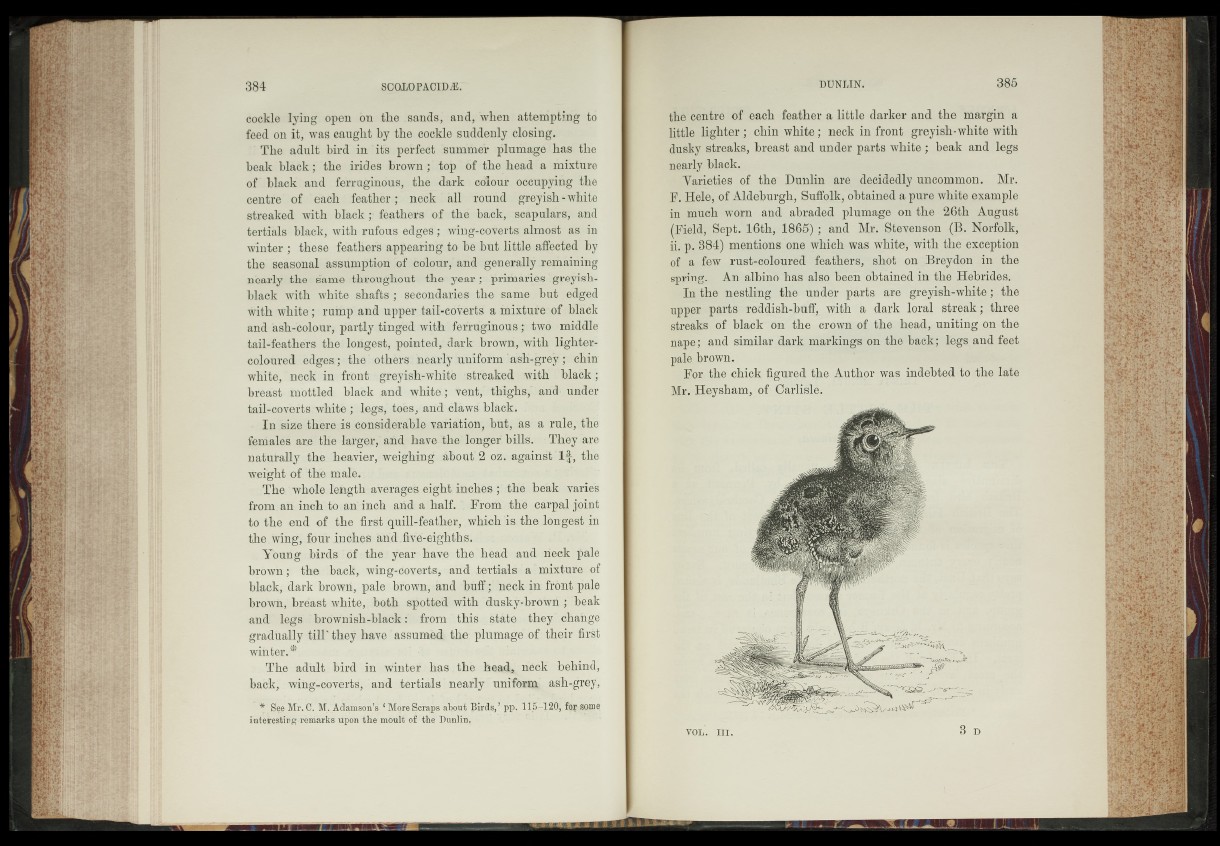
cockle lying: open bn ike sands, and, 'when attempting to
feed on it, was caught by the cockle suddenly closing* J
" The adult bird in ’its perfect summer pluÄgö has the
beak black; the irides brown; top of'.the; head a mixture
of black and ferruginous, the dark colour occupying the
centre of ‘ each feather; neck ' all found greyish1 white
streaked with black y feathers of the back, scapulars,t and
tertials black, with rufous edgek; wing-coverts almost as in
winter; these feathers appearing to be hut little affected by
the seasonal assumption of .colour, and generally.remaining
nearly th e : same throughout the' year ; primaries greyisb-
black with white shaftssecondaries the same but . edged
with white ; rump and upper tail-coverts a mixture-of?Äck
and ash-colour, partly tinged with "ferruginous-; two • middle
tail-feathers the longest, ipeinfeejdy dark brown, with lighteiv
eoloured edges; the'others n e a r ly iu n i f oEmr f a - c h in -
white,"neck in frönt-greyish-white '.streaked ?with‘T blank;
breast-?m'ottled black .and white«; vent,hthighsy iand' under
tail-coverts white; legs,' toesycand .claws' black» h
- Jn .size thereds considerable, variation, bait, as a rule/gfchB
females are the larger,'and bave-3he' longer They are
naturally the heavier,. Weighing iäbout” 2 oz. against‘I f , the
Weight of/thie male/; /
- >The whole length .averaged eight;-inches ;' the beak sanes
from, ah inch to;an' inch and: älhalf.’dETrom ;the carpaL|oint
to the end of the first quill-feather, which is the longest in
the | wxng,r four in ches and I five'- eighth s,
. Young birds 'of the‘year have-the'head: and meek £ale
b r ow n t h e "back, wing-coverts, and tertials a mixture of
blaek;,- dai!ik brown, pale b te^ ,:an d hüffjffheck in frön^-rpale
brown, breast white, both spotted'with dusikyrbroWn.;' ibeak
and legs' i brownishyblacfe :H<from "tips sl^eii^they'chahgö
gradually till'the ƒ have assumed the plumage* of/their- first
winter;:*.
: . The adiilt bird ‘ in ..winter? has {the head*, neck ^behind-,
back; wingteevOrts, and- tertials 'nearly/ unifOrut ash-grey.,
^■Qee 5tr. 0. If. Adamson’s * Mwe Scraps about Birds,’ p p ^ ll45-120, for some
mleiestfng-Temarks upon the moult oi 'the ]Än]ml5't'-'
the centre of'each feather a little darker and the margin a
little lighter ; chin white; neck in front greyish-white with
dusky streaks, breast and under parts white ; beak and legs
nearly black.
- Varieties of the' Dunlin are decidedly uncommon. ]\Jr.
F. Hele, of Aldeburgb, Suffolk, obtained a pure white example
in much worn and abraded plumage • on the 26th August
(Field, ^Bpt.-k6th, 18^5) ; and Map. Stevenson (33. Norfolk,
ii*..p. 384) mentions*one which was white,- with'the exception
of a few rust-coloured f e a t h e r s , o n .Breydorf inpthe
spring, An albino‘has also’‘‘been obtained in' tle Hebrides.
In the nestling the lindar parts ate greyilh-'white; the
upper parts reddish-bkfip with a dark loral streak; three,
streaks of black on the arnwn of the head,^uniting on the
nape; and similar dark markings-:on the back; CegfL-and feet
pale hr°wn.
^MSpXf dhiek figured the Autbpr’ v^s indebted >'to .the late
Miv-Heysham, -of 'Oar lima.,